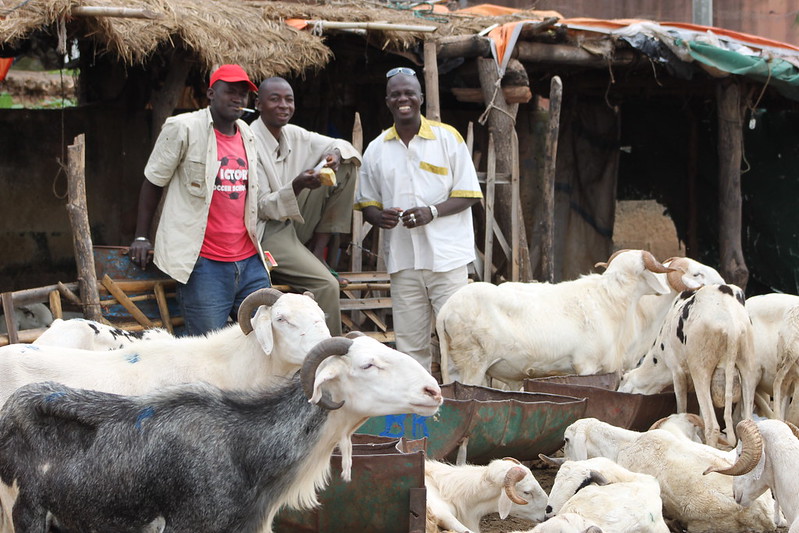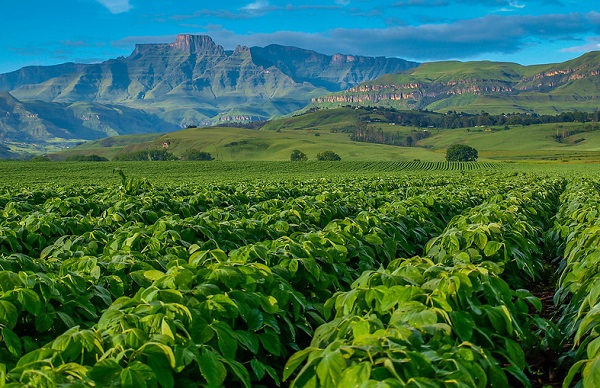Africa adaptation event shines spotlight on climate-smart agriculture
Africa adaptation event shines spotlight on climate-smart agriculture
Climate smart agriculture grabbed the headlines at the Africa anchoring event of the Climate Adaptation Summit – as a way for African communities to tackle climate change impacts, achieve food security, boost incomes and create vibrant rural economies.
The Africa event was a two-hour session focused on how to accelerate adaptation action on the continent, as part of a 24-hour global, online summit, which attracted some 18,000 registrations in total. Mairi Dupar of CDKN reports.
‘Backbone’ of African economies is under threat
Agriculture is a vital sector in Africa – providing between 25% and 35% of direct jobs and a source of revenue for around 70% of the African population, according to the Initiative for the Adaptation of African Agriculture. And yet, agricultural productivity is falling as a result of climate change, compounded by land degradation.
Climate change threatens food security, creating a “stumbling block to our continental target of ending hunger by 2025,” H.E. Josefa Sacko, African Union Commissioner for Rural Environment and Agriculture told the Summit.
Surging temperatures, prolonged heatwaves and droughts, flooding and other impacts of climate change, such as increased prevalence of diseases, affect food production, the accessibility of food, food quality – and, indeed, the stability of the very food system, she added.
Dr. Yannick Glemarec, Executive Director of the Green Climate Fund reminded the Summit that Africa could see reductions in yields of staple crops such as wheat, without strong action on adaptation. (The IPCC’s Fifth Assessment Report on Impacts, Adaptation and Vulnerability to Climate Change, estimated aggregated losses of 22% in crop yields by mid-century across sub-Saharan Africa.)
Africa’s agriculture sector not only faces climate risks – but multiple hazards including the present locust plagues. While “Africa’s growth is being compromised by climate change, the sight of locust swarms devastating thousands of hectares of crop land in East Africa was shocking,” said Akinwumi Adesina, President of the African Development Bank (AfDB).
A value chain approach
A raft of actions are planned and many are already underway at the regional level to boost crop and livestock productivity and help African agriculture to adapt to climate change. So great is the importance of agriculture – Commissioner Sacko stressed – that it “requires a multilateral approach.”
The AU Commission sees opportunities for adaptation across the entire agriculture value chain: from field, to farm gate, to storage, distribution and marketing. Tackled holistically, ambitious adaptation action will not only stabilise the agriculture sector in the face of climate risks. It will enable the sector to be an engine of economic growth and human development.
“Renewable energy, energy efficiency, a just transition programme, nature-based solutions and biodiversity, sustainable land management, resilient agriculture [practice], enhancing information communications and technology and climate-smart development could drive a major increase in agricultural production output,” Commissioner Sacko said.
Choosing varieties and technologies to boost production
Selecting (or breeding) appropriate crop varieties to thrive in the changing climate is priority for Africa’s young generation of farmers. “I asked young people before the Summit what their priorities are, for climate change adaptation,” reported Kitty van der Heijden, Director General for International Cooperation at the Netherlands Ministry of Foreign Affairs. “They said: drought resistant crop varieties and solar-powered irrigation.”
A substantial AfDB initiative is already underway in 27 countries – the Technologies for African Agricultural Transformation (TAAT) programme, to help the continent “fulfil its enormous potential in the sector by employing high-impact technologies to boost output.” The TAAT programme has already provided 19 million farmers with climate-resilient agriculture technologies in 27 countries, such as drought-resistant high-yield varieties of seed and water- efficient irrigation for dry season use. It has raised farmer’s yields by 60%.
Hafez Ghanem, Vice President Eastern and Southern Africa for the World Bank, also spoke to the promise of green technologies to help boost yields: “We need to ensure food security by developing climate smart agriculture. New technologies are allowing that,” he said. An Ethiopian project is extending climate-smart small-scale irrigation to farmers, as well as improving smallholders’ tenure arrangements. Similar World Bank-funded projects to support small and medium-sized farmers and agri-enterprises operate in Niger and Tanzania.
Gender and social inclusion approaches are important to help all farmers who could benefit to gain access. Ms van der Heijden stressed: “we must help women to benefit, who often don’t have land tenure and collateral to invest in climate smart technologies.”
Weather and climate information services
Agriculture and pastoralist livelihood systems depend heavily on weather forecasts – from daily to weekly to seasonal. Timely, accurate forecasts can often help people protect their livestock from adverse weather, or influence the timing of planting, harvesting and other farming events.
Indigenous and local knowledge is helpful in predicting near-term weather, and the routine turn of the seasons. However, seasonal timings and the intensity of heat and rainfall are now disrupted by climate change. Modern meteorological science can aid farmers and pastoralists with longer-term forecasts, for the days, weeks and months ahead, and can provide extreme weather alerts.
Commissioner Sacko expressed the AU Commission’s commitment to “strengthening the climate service value chain” on the continent – which describes how meteorologists produce forecasts, and work with sectoral specialists (such as agricultural advisory services) or mass media (like community radio) to inform communities how they may be affected by the weather, and what action to take.
The Summit also held a parallel session on agriculture and food security at which international organisations and governments discussed their Investment Blueprint for Digital Climate Advisory Services – to finance the scaling up of digital advisory services to 300 million smallholder producers worldwide by 2030. The Digital Climate Advisory Services initiative already intends to extend services to at least 30 million small-scale farmers in Africa by 2025.
Ramping up finance
A new initiative of the AfDB and Global Centre on Adaptation was announced on 25 January, called the Africa Adaptation Acceleration Programme. This will build on the successes of the TAAT scheme and scale up the Bank’s backing of technologies “for Africa agricultural transformation,” AfDB President Adesina said. The Programme aims to galvanise US$25 billion for African adaptation by 2025.
Finance is exactly what’s needed, and in much greater volumes, for climate-smart agriculture now – according to Ms. Abir Lemseffer, Director-General of the Adaptation of African Agriculture Initiative (AAAI). The AAAI which has already developed climate-smart investment plans for the agriculture sector for several African countries.
“We are working on finance leveraging – there are lots of plans and tools that are ready in the adaptation field, especially in agriculture. If I can leave you with one message today, it’s: ‘Please don’t try to reinvent things and spend more time and money on [planning] – lots of work has already been done,’” she urged.
The current need, Ms Lemseffer said, is to translate climate-smart plans into “real projects based on very strong involvement of the public and private sector.”
Pioneering farmers have proven the “scheme and approach of climate-smart agriculture on the ground” and can demonstrate successful practices to others. Early climate-smart agriculture pilots can be replicated more broadly. Farmer-to-farmer exchange programmes and knowledge networks are further documented in CDKN’s working paper ‘Accelerating adaptation action in Africa: Insights from African experts.’
Business sense
The private sector is in on the act – because it makes business sense. Rebecca Marmot, Head of Corporate Social Responsibility for Unilever, showcased climate-smart agriculture in the Summit’s closing talks.
“Adaptation is something we are trying to tackle, as climate change is impacting the business across the business value chain, from where we are growing raw material to communities who are consuming our products,” she said.
While Unilever has joined other large corporations in making zero-emissions pledges (theirs by 2030), Ms Marmot said they cannot tackle climate mitigation without also addressing adaptation.
“Over 70% of freshwater around world is used for agriculture, and lack of water can destroy a whole harvest. Water scarcity for us is a huge challenge in the countries where we’re sourcing our crops and we’re seeing that becoming even more volatile.”
A case in point is water-stressed South Africa, where Unilever is now partnering with WWF to help farmers produce herbs with far less water.
They have a vision for the company’s agricultural operations, which could as well serve as a mantra for agriculture, everywhere:
“Invest in regenerative agriculture: nourishing the soil, increasing biodiversity, and increasing climate resilience.”
Watch more
The CGIAR Research Program on Climate Change, Agriculture and Food Security (CCAFS) conducted digital consultations in January 2021 on ‘Priorities for Climate-Resilient African Food Systems’. The video below shares key recommendations from these. They include proposals for innovation exchanges and digital disruption – such as creating a ‘Silicon savannah’ – to catapult African farming toward a more resilient future.
Read more
You can read more of CDKN’s coverage of the Climate Adaptation Summit here:
Accelerating climate-resilient economies in Africa
Generation restoration: adapt for our future
Restore Africa's degraded land: Climate Adaptation Summit
Images: above right (Kenya) - credit Cecilia Schubert; above, top (Mali) - credit Jessica Davis; above, bottom (South Africa) - credit R Ribeiro. Video - credit CCAFS.


